A beautiful smile makes a person confident and attractive to others. Aesthetic dental restoration allows you to achieve the desired result very quickly.
Record content:
- 1 Average price and types of procedure
- 2 Advantages and disadvantages
- 3 Indications
- 4 Contraindications
- 5 What examinations need to be done
- 6 Training
- 7 Procedure step by step
- 8 Recovery after
- 9 How long will the result last
- 10 Possible complications
- 11 Video about aesthetic dentistry
Average price and types of procedure
Aesthetic tooth restoration offers the following types of procedures:
- straight line - actions carried out directly in the patient's cavity;
- indirect - the creation of structures in the laboratory after taking impressions and fixation of the finished product.
This operation allows you to eliminate the following defects:
- correcting the shape and size of the tooth;
- repairing cracks and chips on the enamel;
- discoloration of the tooth when other methods are ineffective.
The cost of the procedure includes the following indicators:
- the status of the medical institution and the qualifications of its specialists;
- volume of work carried out. This can be a complete or partial restoration of a tooth, as well as a spot repair of chips;
- anesthetic drugs used;
- used for work latex cofferdams;
- fixation pins. Depending on the material from which they are made;
- consumables used for the procedure - sterile bandages, masks, shoe covers;
- the complexity of preparatory measures, for example, grinding a tooth, taking a clear impression and direct manufacturing of a microprosthesis.
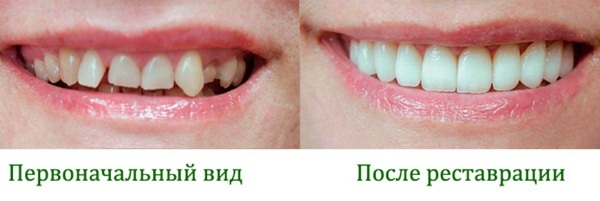
The approximate cost of the services provided is as follows:
- restoration of a chip edge of a tooth - about 1600 rubles;
- restoration of the crown and installation of a fiberglass pin - from 5000 rubles;
- tooth augmentation by 1⁄2 height - from 3500 rubles;
- restoration of the crown using a metal pin - from 4000 rubles;
- anesthesia - from 200 rubles;
- sterile latex napkin - from 350 rubles;
- consumables - 100 rubles;
- a prosthesis made of composite material - from 3000 rubles;
- ceramic veneer - from 12,000 rubles;
- price of work - from 1500 rubles.
Advantages and disadvantages
The basis for the procedure is the need for artistic or cosmetic dental restoration.
The main advantages include:
- speed of restoration of teeth. Modern techniques allow you to get rid of complex problems in 1 day, and not walk for a whole week with a temporary filling, traumatizing the tongue on the sharp edges of a sharpened tooth;
- attractiveness of appearance. Defects become invisible;
- acceptable price for the average client.
The disadvantages of the procedure are:
- rapid wear of the material and change in its color over time;
- the ability to fix minor defects. In case of large destruction, experts advise using tougher methods of restoration.
Indications
Restorative dentistry allows teeth to be restored in a few days. Such aesthetic procedures are characterized by relative accessibility and slight pain during the procedure.
The indications for its appointment are:
- external unattractiveness;
- small damage to the enamel in the form of chips and cracks;

- the presence of gaps between the teeth;
- the appearance of dark spots or yellow plaque on the teeth;
- unaesthetic form. The teeth are too small or too large;
- improper placement in the mouth;
- the presence of old, dilapidated seals;
- too thin layer of enamel;
- a defect in the bite of the teeth or a slight violation of their position;
- complete or partial absence of 1 or more teeth.
The main goal of the restoration performed is to eliminate teeth imperfections visible to the eye, visible when smiling. This technique extends the life of your teeth, preventing prosthetics as much as possible without compromising the patient's health.
Contraindications
The restoration can be carried out on any groups of teeth. To choose the correct method of treatment, patients are assigned consultations with specialists.
A categorical prohibition on carrying out the procedure with light-cured composites is given when:
- the patient has a heart rate stimulator. When you turn on the photopolymerization device, the frequency of the supplied pulses may be violated or the device may fail;
- the presence of high sensitivity to the components included in the adhesive system or composite;
- inability to cleanse the oral cavity from a large amount of moisture.
Relative contraindications can be:
- the presence of a direct bite and increased abrasion of tooth tissue. In such cases, the possibility of restoration is considered only after bite correction by an orthopedist;
- with a vertical malocclusion, when the upper incisors strongly cover the lower ones. In this case, the increase in the length of the teeth is carried out carefully, because the mouth will stop closing;
- the presence of bruxism. This disease is characterized by involuntary clenching of the jaws as a result of contraction of the masticatory muscles. This is an unpleasant process, accompanied by gnashing of teeth;

- non-compliance by the patient with the rules of oral hygiene.
What examinations need to be done
Aesthetic tooth restoration requires a preparatory stage, which consists of the following activities:
- Tests for the presence of hepatitis, HIV, as well as blood sugar.
- Elimination of foci of inflammation and decayed teeth. Caries and root canal treatment.
- Making an overview of the oral cavity (orthopantomogram).
- Consulting with specialists such as endocrinologist, internist, ENT and cardiologist.
It is important that a complete sanitation of the patient's mouth is carried out. Without this, no specialist will carry out the aesthetic restoration procedure.
The cost of the procedures depends on the complexity of the problems and can reach 10-15 thousand. rub.
Training
In addition to direct treatment, teeth are cleaned of plaque and tartar. After that, it will be easier to choose the right tone of material for the restoration procedure. The shade should match the natural tone of the enamel. If the differences are noticeable, the smile will seem unnatural.
If there are open wounds in the mouth or a woman is expecting a baby (especially in the first and last trimester of gestation), the restoration is postponed until the wounds or childbirth are completely healed. It is forbidden to make a composite restoration immediately after tooth extraction or treatment.
In difficult cases of restoration, the following specialists are involved:
| Specialist | Description |
| Dentist-Hygienist | He sanitizes the oral cavity and prescribes preventive procedures |
| Orthodontist | Establishes the correct position of the upper and lower jaw. Usually, bracket systems are installed for this.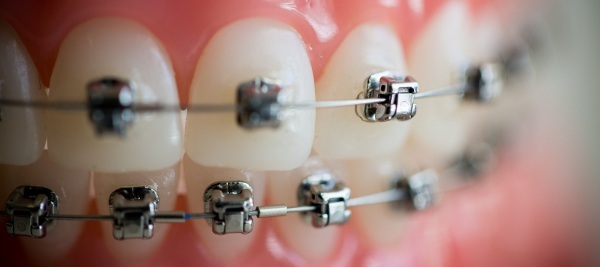
|
| Periodontist | Performs aesthetic correction of the gums, as well as reveals the presence of periodontal pockets and prescribes the best treatment options |
| Orthopedist | Places dentures, motes or single crowns |
| Gnathologist | It is necessary for disorders of the temporomandibular joint |
Most procedures are performed under anesthesia. Most often, local anesthesia is performed.
Procedure step by step
Aesthetic tooth restoration can be carried out in several ways. The purpose of the procedure with the direct or indirect method is to eliminate the imperfections in the dentition and to select a material that is close in color to the shade of the client's enamel.
Restorative procedures with the direct method are carried out in the oral cavity. After them, the appearance of the restored tooth should not be discordant with adjacent untreated teeth. It will be impossible to remove the superimposed material even for dental specialists. Any removal can destroy the crown in whole or in part.
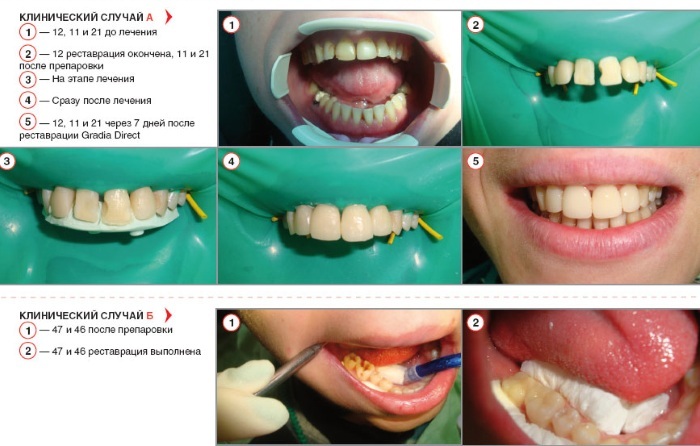
The direct method includes restoration:
- composite type. It is made using photopolymers. This is a special filling compound that easily hides minor problems with the shape and color of the tooth. The advantage of the operation is that it can be performed in 1 visit;
- using tabs. This is the classic way to patch up defects. They can be temporary or permanent (metal or ceramic);
- inserting pins. It is carried out in case of significant tooth decay. Even if a small part is visible, it can be easily restored by inserting a metal needle into the root canal and building a frame made of a special material around it.
The indirect method involves taking impressions.
The principle of operation is as follows:
- An impression is made in the likeness of a healthy tooth located on the other side of this jaw. If this is not possible, a model of the jaw is made on the computer, in which the missing segment is drawn to the desired size.
- On the basis of a 3D model or a live impression, onlays are made in the laboratory for fixing on the problem tooth. The procedure is time consuming. If necessary, the pads are quickly dismantled in any dental office.
- After installation, the surface of the tooth is ground.
There are the following types of prostheses:
| Prosthesis type | Description |
| Crown | It fits over a pre-ground tooth base or an installed pin. Its outer side has the shape of a tooth before it is damaged (it is restored using a virtual model). Such restoration is carried out with significant lesions of dental tissues and the impossibility of restoring them in another way.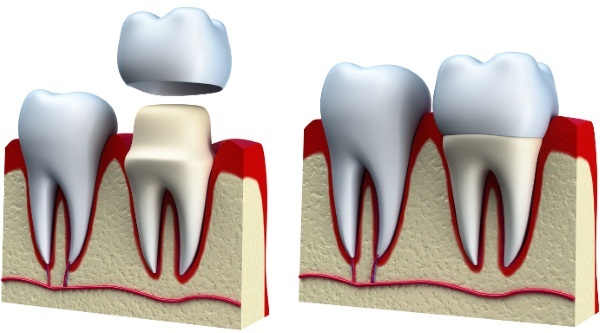
|
| Veneers | A type of prosthetics in which special attention is paid to the elimination of the aesthetic imperfections of the teeth (color and shape). It is made from a thin ceramic plate. This is one of the modern ways to restore the beauty of a smile. |
| Lumineers | A kind of material for prosthetics. Tooth pads are made of very fine, high quality porcelain. It is better to take them off in a dental clinic. |
With composite restorations, the filled teeth do not require turning. The only thing that may be required is to remove the old seal.
For this:
- On the surface of the tooth, 2 thin grooves are drilled, which will limit the place of polymer installation.
- To degrease the enamel, the treatment site is treated with a special compound.
- A layer of polymer is laid.
- After drying under a special lamp, the next layer is applied.
How many layers are needed in each specific case is decided by a specialist. Despite the speed of the operation, it is painful and requires the introduction of anesthetic. The method is suitable mainly for the front teeth. Chewing units will be difficult to recover with this method.
The installation of onlays requires additional removal of the nerve and filling of the problematic canals. First, a temporary filling is placed. Then it is replaced with a permanent one, in the hollow of which a patch is made, duplicating the missing elements, restoring the chewing function. It will be difficult to notice the repair area when the surface of the onlay is covered with ceramic.
Reconstruction with pins is the first stage in restoring the integrity of the tooth, while the damaged tooth is not removed. A hole is drilled into the root canals, where the pin is screwed in. The channel is cleaned as much as possible and a metal rod is inserted into it.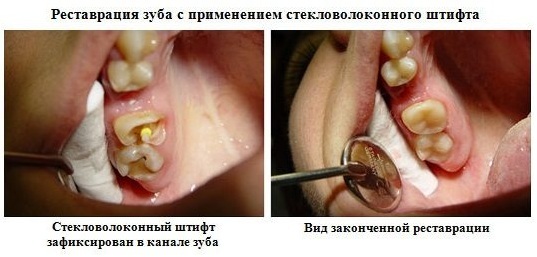
For fixing, the installation site is treated with a fixing compound. After it dries, the missing elements are built up. The main disadvantage of this method is the possibility of tooth splitting.
Prosthetics with crowns is carried out after the treatment and grinding of the tooth. Even if no pain is felt, it is best to remove the nerve. In addition, the surface must be disinfected: if the infection begins to develop under the crown, it will have to be removed and everything must be done again. After that, an impression is made in the desired shape. Crowns can be made of ceramics or cermets. Rarely is plastic used for this purpose.
The procedure for installing a crown is time-consuming. It will take at least 3 visits to the dentist. In order for the impression to have an ideal shape, the tooth is ground down to a fine state.
When using a post, turning is not carried out, because it is ideal for all types of crowns. Ultimately, the crown will completely cover the remaining tooth or post.
Metal structures sometimes lead to discoloration of the gum tissue at the junction with it, therefore, experts prefer porcelain, hypoallergenic crowns.
Recovery after
Aesthetic tooth restoration gives a beautiful smile, however, in order to preserve the result after carrying out the procedure, you should strictly follow the doctor's recommendations for oral care and the rules of admission food. Otherwise, beauty will quickly disappear and problems will return.
The rules of care after aesthetic restoration are as follows:
- some foods should be temporarily excluded from the diet or their consumption should be minimized. This will help maintain a white-toothed smile for several years;
- use soft bristled brushes when brushing your teeth;
- use special rinses after cleaning;
- several days after the procedure, as a preventive measure, rinse your mouth with a disinfecting decoction from oak bark and pine buds. This is done after every meal;
- use dental floss to clean the gap between the teeth;
- give up hard candies, dryers and crackers;
- try not to eat foods with a lot of dye (tea, coffee, coca-cola, red beets);
- quit smoking;
- avoid eating foods high in corrosive acids;
- use alcohol-containing substances with caution. It has a negative effect on many materials and can damage the restored tooth surface;
- if there is a peculiarity of teeth grinding in a dream, it is worth wearing special mouth guards at night.
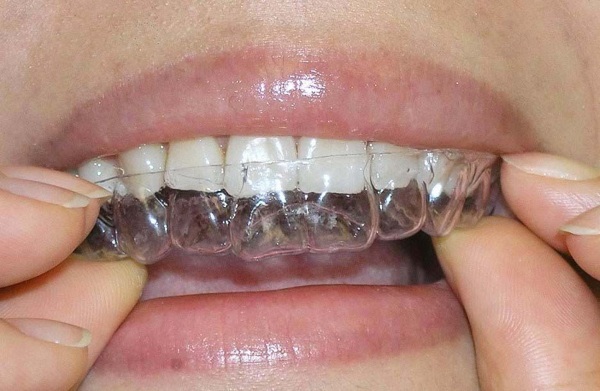
For prevention, you should periodically visit the dentist.
How long will the result last
The preservation of the result depends on the person's lifestyle, compliance with the rules of oral hygiene and diet. On average, the appearance of a restored tooth does not change within 1-12 months.
As soon as the first changes appear, it is necessary to carry out restoration measures again. The number of rework can be limited, because the tooth tissue becomes thinner after each time. Ultimately, you will need to put crowns on them.
In addition, the restoration procedure often affects adjacent teeth, which will need to be restored in the future. When deciding to carry out an aesthetic restoration, the possible consequences should be weighed.
Possible complications
Errors are possible with aesthetic restoration.
They are divided into several groups:
| Error group | Description |
| Diagnostic | In this case, the wrong treatment may be prescribed, which will lead to carious complications. Therefore, before making a diagnosis, the patient undergoes an examination. |
| Manipulation | Such errors occur in the following situations:
|
| Technical | They come to light at the final stage of work when polishing and grinding the surface:
|
One of the serious complications is the increased sensitivity of the teeth after the procedure.
Experts divide it into:
- true. This sensitivity appears after the operation and manifests itself when biting off the restored tooth. The reasons for its appearance are violations of the technological process or the wrong choice of material, as well as insufficient adhesion of the polymerization layer or its significant shrinkage;
- false. Associated with grazing during the work of tooth tissues. The patient feels pain when brushing teeth and eating food that is too cold or hot. It is treated by taking fluoride and desensitizing drugs. In addition, problems can be caused by a deep carious process. This pain usually goes away over time.
Modern technologies allow you to have a beautiful smile even in the presence of dental defects. The situation can be corrected using the restoration procedure. It will help restore the whiteness of the enamel, hide the existing cracks and chips, as well as those that violate the integrity and incorrect position of the units of the dentition.
Before aesthetic restoration of teeth, it is necessary to undergo an examination in order to exclude negative consequences. To save the result, you need to follow the rules developed by the dentist. Then it will be possible to save the obtained result for a long time.
Article design: Vladimir the Great
Video about aesthetic dentistry
Aesthetic restoration of the anterior group of teeth:



